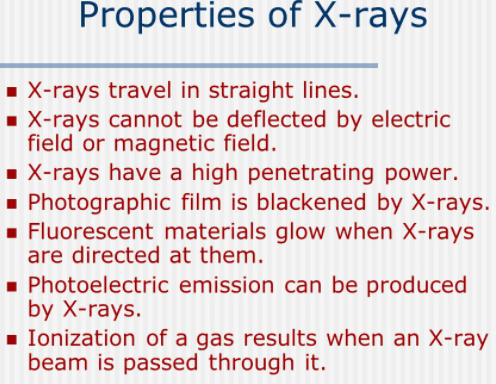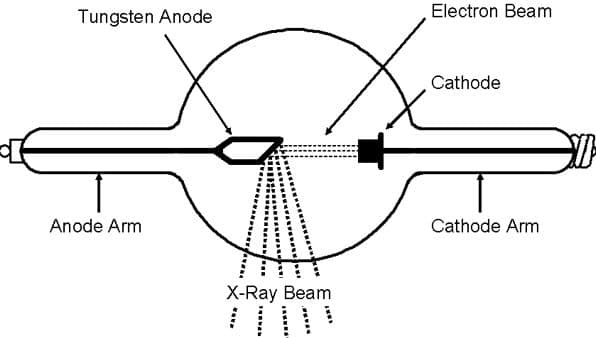X rays uses,properties and applications

What are X rays ?
X-rays are the electromagnetic waves that are emitted by the atoms of those metals which have a large atomic number, a large number of protons in their nuclei so that the pull of the nuclei on their electrons is very large.
When an electron of K or L shell of such an atom is displaced from these shells to the outer shells by supplying it with energy and then allowed to fall back into the same shell, it gives up the energy that it had absorbed in the form of X rays.
The energy is supplied to the electrons of the atom by primary electrons which are accelerated by applying a potential difference.
Who Discover X rays?
Rontgen who was performing experiments with a discharge tube in 1895 found that the tube affected the piece of paper coated with barium Platino cyanide due to some unknown rays which were emitted from it. He called this unknown radiation X-rays.
What are important methods for production of X-rays?
There are many methods for the production of X-rays in the laboratory. Here we will discuss two methods.
1:Coolidge tube:
In 1913 Coolidge developed an X-ray tube which was easier to control than the gas type. This tube is known as the Coolidge tube after his name.

In Coolidge, tube electrons are emitted from a heated filament F of tungsten placed in a highly evacuated glass tube. The filament may be heated by a battery or a step-down transformer.
The filament is generally surrounded by a metallic cup shape to achieve the proper focusing of the electron beam. By varying the temperature of the filament, the number of electrons emitted can be controlled. The electrons are accelerated towards a metallic target by the potential difference supplied by the Battery. The target also acts as an anode when the electrons strike the target X-rays are emitted.
What are properties of X-rays?
- There are not deflected by electric and magnetic fields. This property distinguishes them from the cathode rays and also shows that they do not consist of charged particles.
- They are propagated in straight lines with the velocity of light.
- They affect a photographic plate and even more effective than light.
- They ionize the gases and also eject electrons from certain metals on which they fall.
- They cause fluorescence in many substances e.g, barium Platino cyanide, cadmium tungstate, zinc sulphide.
- They are highly penetrating and can pass through many substances which are opaque to ordinary light.
- X-rays being electron magnetic waves can be reflected, refracted, diffracted and polarized under suitable conditions.
- When X-rays are scattered by a substance, the later also emits some new rays, called its characteristics X-rays whose wavelength depends upon the nature of the substance.
- They have a destructive effect on living tissues.
- X-rays when scattered by the atoms or certain substances undergo a decrease in frequency. This effect is called the Compton effect.
X rays uses and applications
- Radio Therapy
X-rays kill the diseased tissue of the body. Hence they are used to γ cure intractable skin diseases, malignant tumors, etc. If the affected part is superficial soft rays are applied and for deep-seated organs, hard rays are used.
- Engineering
Because of high penetrating power, they are used to investigate the structure of metals, tests of castings for flaws and gas pockets causes of weakness in structure and to detect cracks and below holes in metal plates. The method has the advantage that unlike some mechanical tests it does not destroy to piece.
- Surgery
X-rays can pass through the flesh through bones. They are of extensive use in surgery to detect fractures, foreign bodies, diseased organs, etc. The patient is made to stand between an x-ray source and a fluorescent screen. Thus a deep shadow of the bones and a light shadow of the flash will be obtained. A photograph may also be obtained, it is called a radio-graphic.
- Industry
X-rays are employed in the industry to detect defects in motor tires, golf and tennis balls, wood and wireless valves, and testing the presence of pearls in oysters.